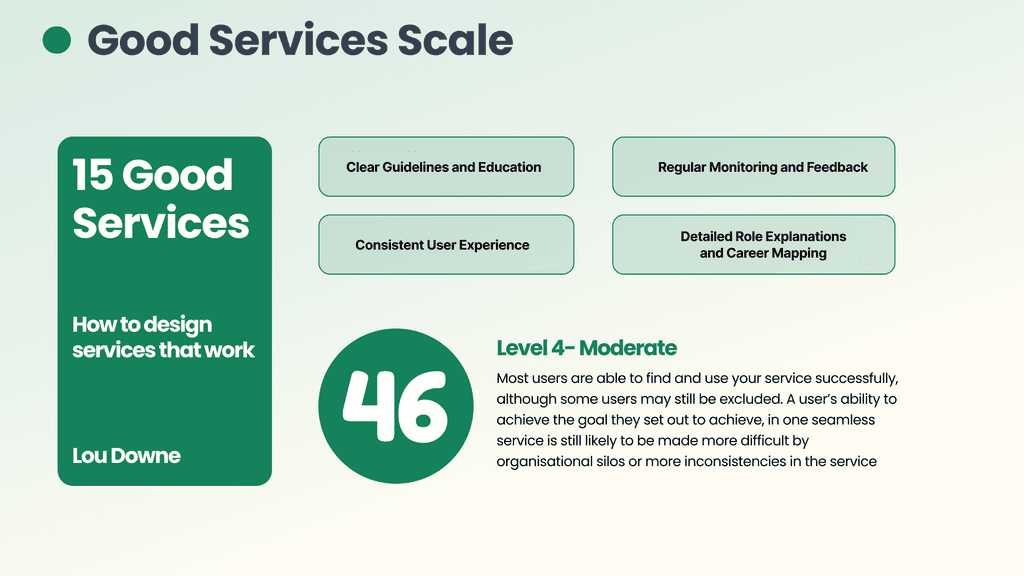Career Up! - Sparck (BJSS) Industry Project
Empowering Communities, Extending Device Lifecycles

8
Weeks
Industry collaboration with Sparck as part of my Master’s program, positively reviewed for its user-centric design and responsible innovation principles.
Summary:
CareerUp! is a digital career mapping service designed to help students explore and align their personal interests, skills, and academic backgrounds with suitable career paths. Developed in collaboration with Sparck, the platform provides personalized career guidance through an AI-powered system, offering features such as career mapping, mini-job opportunities, and real-world testimonials. The goal is to help students make informed decisions about their education and career choices while addressing the key challenges of work-life balance, real-world experience, and confidence in career decisions. My role as the Service Designer involved conducting user research, creating user personas, and ensuring the final product was both user-centric and aligned with the principles of Responsible Innovation.
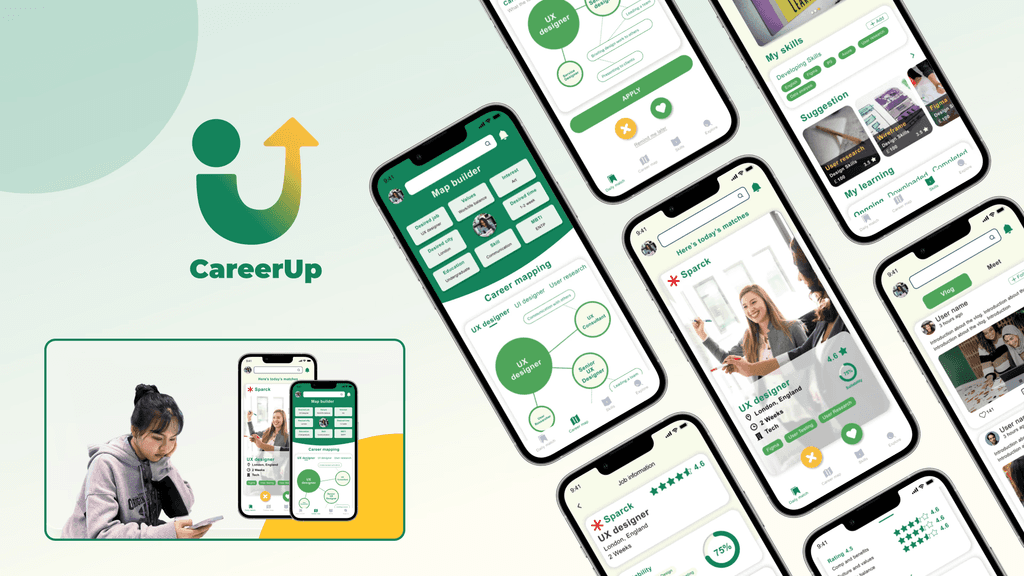
Process
Defining the Problem
Students often struggle with choosing the right career path due to unclear information about job roles, limited real-world experience, and uncertainty about how their personal interests align with their career choices. Traditional career guidance tools focus too much on academic achievements, leaving gaps in understanding how personal values, passions, and practical experiences play into career decisions. This lack of comprehensive, tailored career advice can lead to confusion, underemployment, and dissatisfaction in career choices.
Service Concept:
CareerUp! is a digital service that empowers students to discover and map out potential career paths that align with their personal interests, skills, and aspirations. The platform leverages AI-driven insights and provides real-world experiences through mini-job opportunities. It guides users through the process of exploring various roles, offering tailored job recommendations, and enabling them to gain a practical understanding of different careers before making long-term decisions.
Key Features:
Career Mapping: An interactive, AI-powered tool that suggests career paths based on user profiles, skills, and interests.
Mini Jobs: A feature that offers short-term projects and internships, helping students gain hands-on experience in different fields.
Personalized Job Matching: AI-driven recommendations of job roles aligned with students' academic background and skill set.
Real-World Testimonials: Insights from professionals and alumni about specific roles, offering a realistic preview of career paths.
Research
Process
The research phase for CareerUp! focused on gaining a deep understanding of students’ challenges in navigating career decisions and identifying the essential features needed for a personalized career guidance tool. This phase aimed to uncover insights about students' goals, motivations, and pain points, which informed the development of an effective solution.
Research Goals:
Identify the primary obstacles students face in choosing career paths.
Understand what students desire in career guidance, including the types of information and support they find most valuable.
Determine the impact of practical experience on students’ confidence in career decisions.
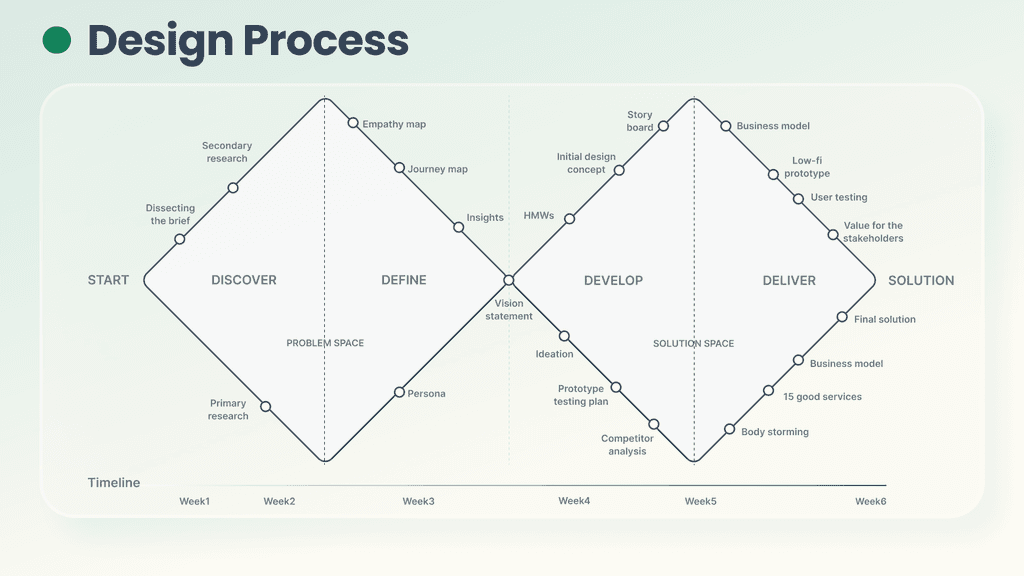
Research
Tools and Methodologies Used
Secondary Research:
Conducted a comprehensive review of existing digital career services and educational resources. We examined industry reports and job market trends to understand broader challenges like employment rates, skills demand, and existing support gaps in career guidance.
Secondary research provided a baseline of general industry insights, which helped define the project’s scope and clarify the unique value CareerUp! could bring to the career guidance landscape.
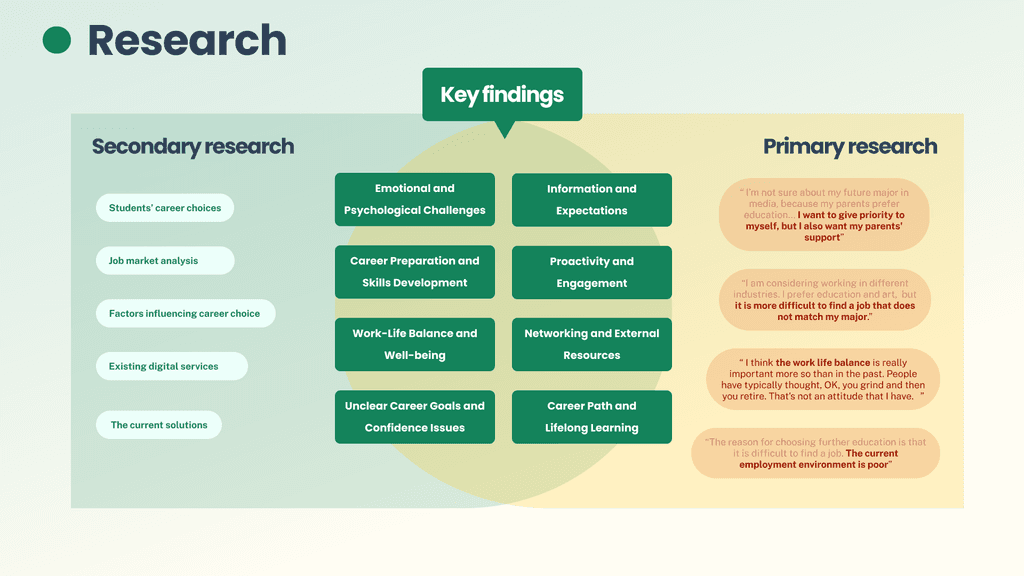
Primary Research:
Interviews: Semi-structured interviews with undergraduates, recent graduates, and career advisors were conducted to gather qualitative insights into individual experiences, expectations, and concerns.
Surveys: To broaden the dataset, we deployed online surveys targeting students at various stages of education. This quantitative approach helped us understand common patterns, such as the most frequently encountered challenges in career planning.
Personas and Empathy Mapping: Based on the interview and survey results, we created user personas and empathy maps to represent the typical student journey and mindset, allowing us to identify common pain points and emotional drivers.
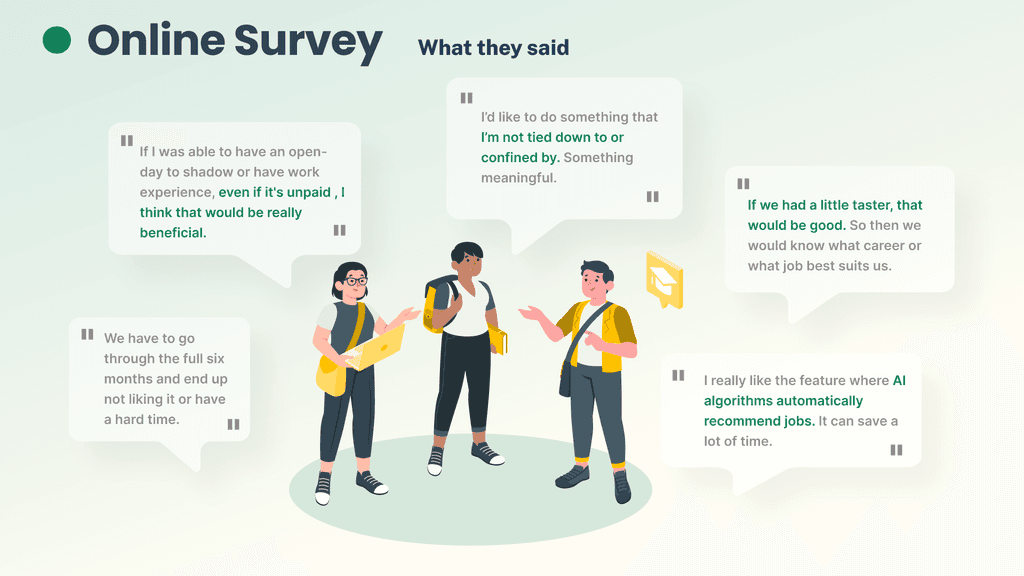
Data Analysis Tools:
Affinity Mapping: We used affinity mapping in Miro to categorize and prioritize insights from interviews and surveys, clustering responses around key themes like career confidence, work-life balance, and access to resources.
How Might We (HMW) Statements: From these insights, we generated HMW statements to guide ideation, such as, “How might we provide clear and accessible information on career paths?” and “How might we integrate real-world experience to build student confidence?”
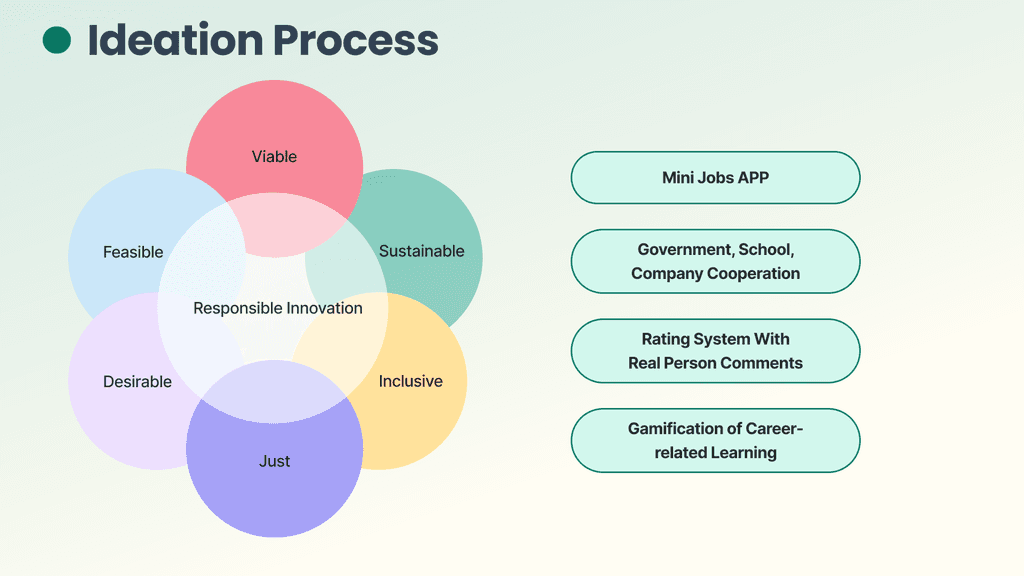
Research
Key Findings
The research phase yielded valuable insights that shaped the CareerUp! service, revealing specific needs and challenges faced by students in career decision-making. These findings highlighted essential areas for the service to address, ultimately forming the foundation of CareerUp!’s design.
Unclear Career Goals and Pathways:
Many students struggle with identifying clear career paths aligned with their skills and interests. They expressed a need for guidance that moves beyond traditional academic metrics to focus on personal passions and real-world application. Students desired a way to “test the waters” in various careers before committing to a path.

Importance of Work-Life Balance and Personal Alignment:
Students prioritized work-life balance and values alignment over traditional career markers. Many expressed that they would prefer a career that aligns with their lifestyle and personal values rather than a purely high-paying role. This finding emphasized the need for CareerUp! to consider personal and lifestyle factors in career recommendations.
Confidence and Practical Experience:
Students frequently reported a lack of confidence in their career choices, often due to limited hands-on experience in their field of interest. They sought practical opportunities, such as internships and mini-jobs, that would allow them to explore roles without long-term commitments. This feedback underscored the importance of integrating real-world experience opportunities within CareerUp!.
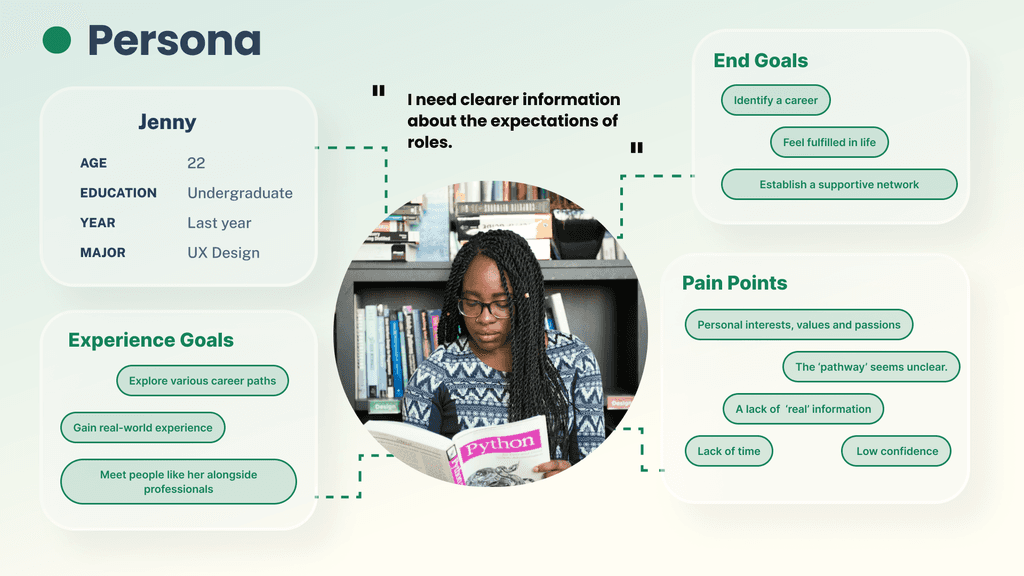
Need for Tailored, Accessible Information:
Career guidance should be accessible, easy to navigate, and personalized. Students expressed frustration with generic career advice and a desire for recommendations that are uniquely relevant to their backgrounds and aspirations. They wanted clear, concise information on roles, with job details and role expectations made readily available.
Supportive Community and Networking Opportunities:
Networking emerged as a significant gap, with students noting a lack of connections in their desired fields. They showed interest in gaining insights from alumni, mentors, and other professionals to help them make informed decisions and build confidence in their career journey.
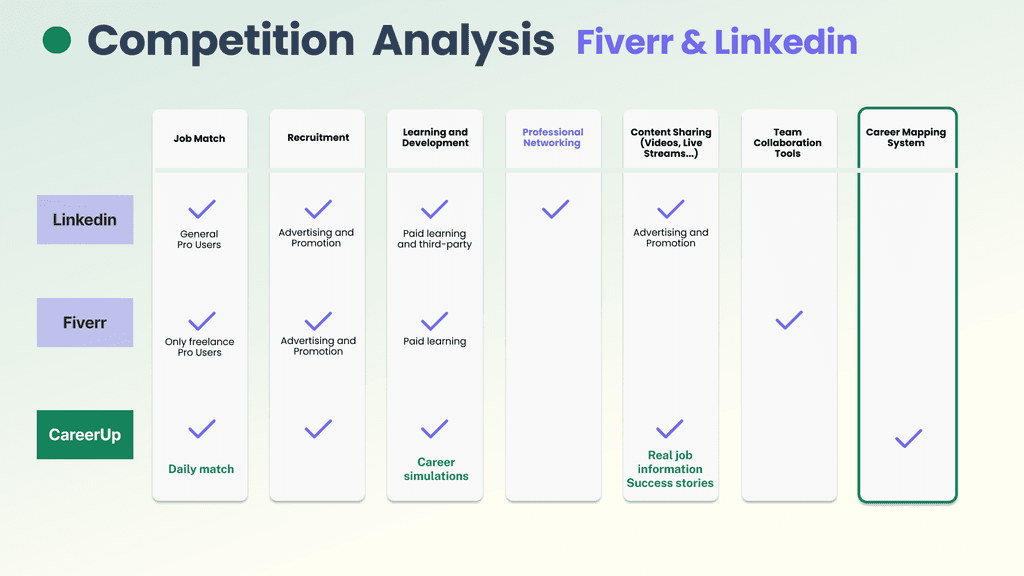
Iterations
Refining CareerUp!
The design solution for CareerUp! was developed through an iterative process that incorporated direct feedback from users, allowing us to refine and enhance the service to best meet their needs. This user-centered, agile approach ensured that each version of the design responded to real-world challenges students faced in career decision-making.
Initial Prototype Development:
The first prototype aimed to create a user-friendly interface with the essential features identified in our research: career mapping, mini-job opportunities, and AI-driven recommendations. We focused on providing a clean, intuitive layout where students could explore career paths and receive job recommendations in a few simple steps.
Key Focus: Basic user journey from registration to career mapping and job recommendations.
Features Included: Initial versions of the Career Mapping tool and mini-jobs feature, along with placeholders for role insights and recommendations.
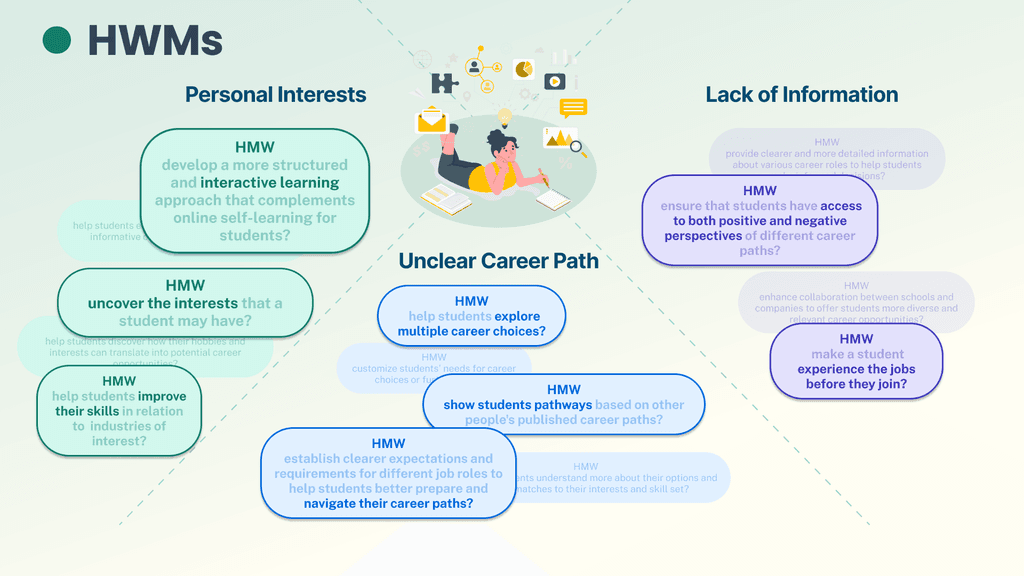
User Feedback and Usability Testing:
Once the initial prototype was ready, we conducted usability testing sessions with student participants to gather feedback on functionality, ease of use, and overall experience.
Feedback emphasised the need for:
Clearer navigation and visual cues to help users navigate between sections.
More detailed role descriptions and real-world testimonials.
Greater customization in the career mapping feature, with filters for location, work-life balance, and values alignment.
This round of testing highlighted the need for a more guided user flow, clearer role information, and visual enhancements to improve the experience.
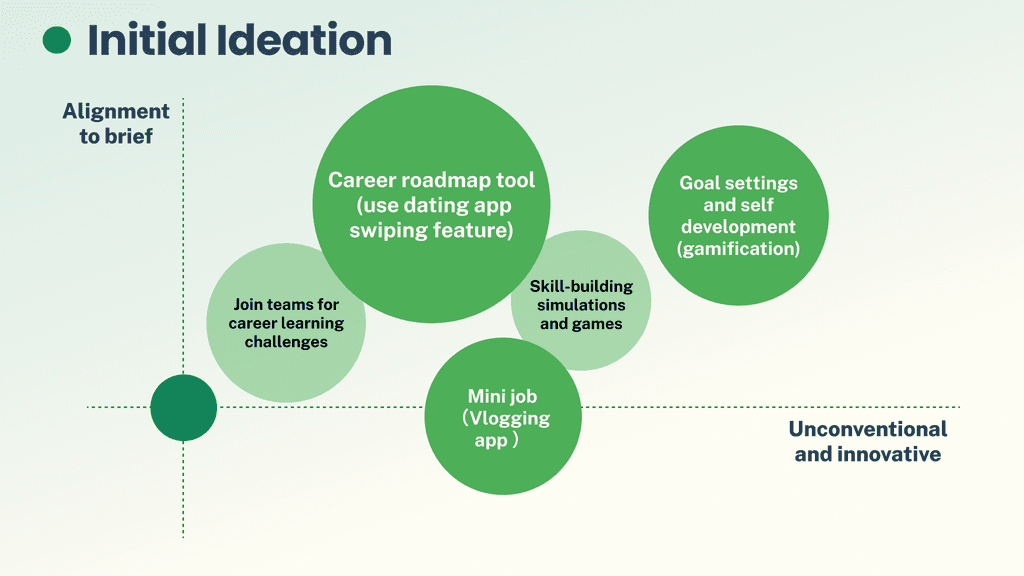
Iteration on Career Mapping and Mini Jobs:
Based on feedback, we redesigned the Career Mapping tool to provide more personalized and detailed insights. Filters were added to allow users to refine career options based on their values, desired work-life balance, and skills. The Mini Jobs feature was also refined, allowing students to access short-term projects directly linked to potential career paths, with the added option of seeing reviews and testimonials from professionals.
Key Adjustments: Enhanced customization in career mapping, detailed job descriptions, and integration of professional testimonials within the Mini Jobs feature.
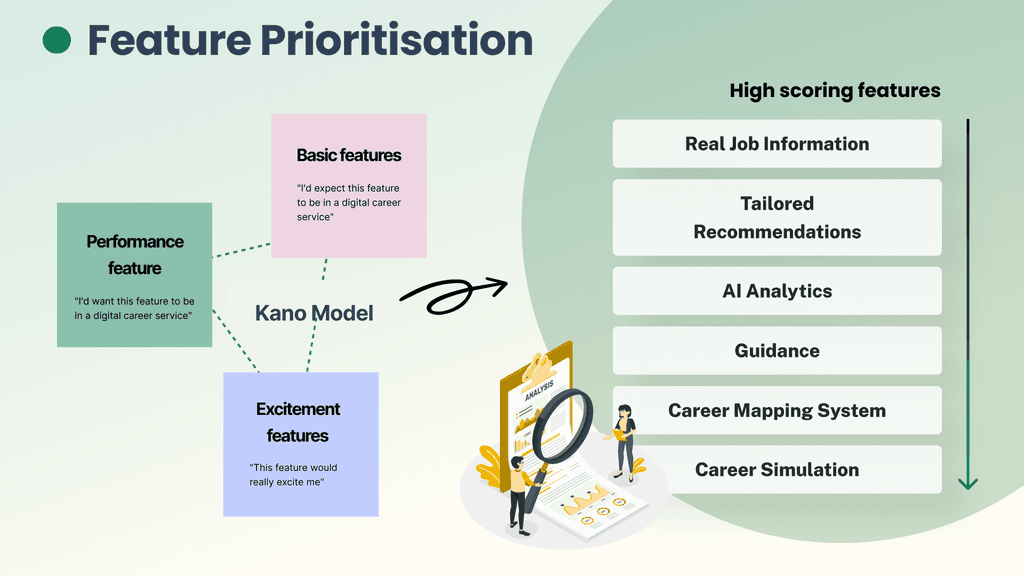
Enhanced Personalisation and AI Recommendations:
In response to feedback, we refined the AI-driven recommendations to deliver highly tailored career suggestions based on each student’s unique profile. This included adding a recommendations engine that used insights from user-provided preferences and history on the platform. Additionally, we improved the UI with a clearer, more engaging visual language and introduced a progress tracker that guides students through their career discovery journey.
Key Adjustments: Improved AI-powered job matching, progress tracking, and a more engaging interface.

Final Prototype Testing and Feedback Integration:
The final prototype incorporated all feedback from the previous iterations and offered a seamless, guided user experience. The design was tested again with new users, who reported that the platform now felt intuitive, supportive, and valuable for career planning. At this stage, CareerUp! was ready for its final release, featuring enhanced user flow, an intuitive career mapping experience, and an actionable mini-jobs feature with professional feedback.
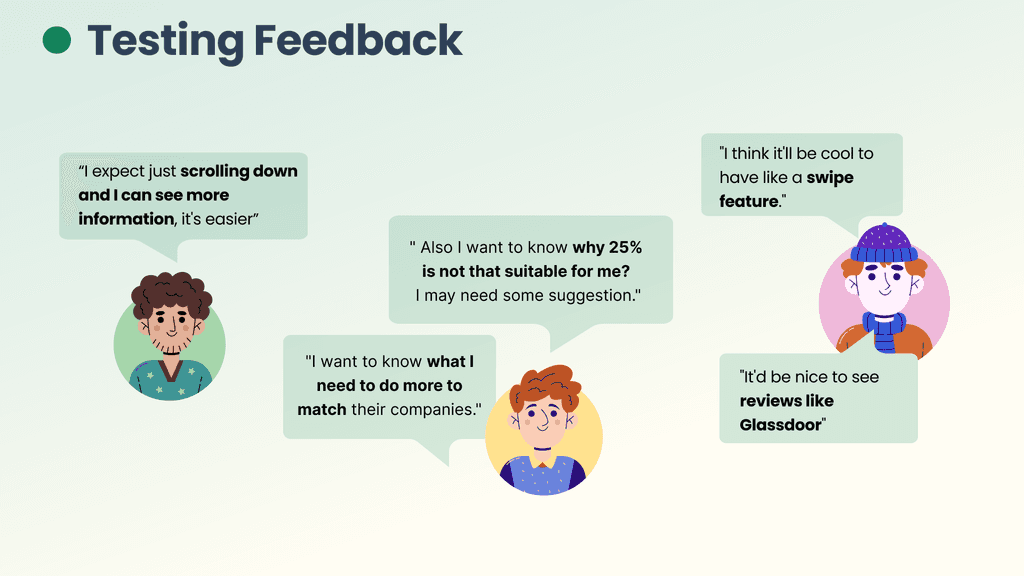
Design Solution
CareerUp!
The final design of CareerUp! combines a suite of interactive, AI-driven tools aimed at empowering students to navigate their career paths with clarity, confidence, and personalized support. Each feature was crafted to address key pain points identified during the research phase, with a focus on creating a seamless, engaging, and supportive experience.
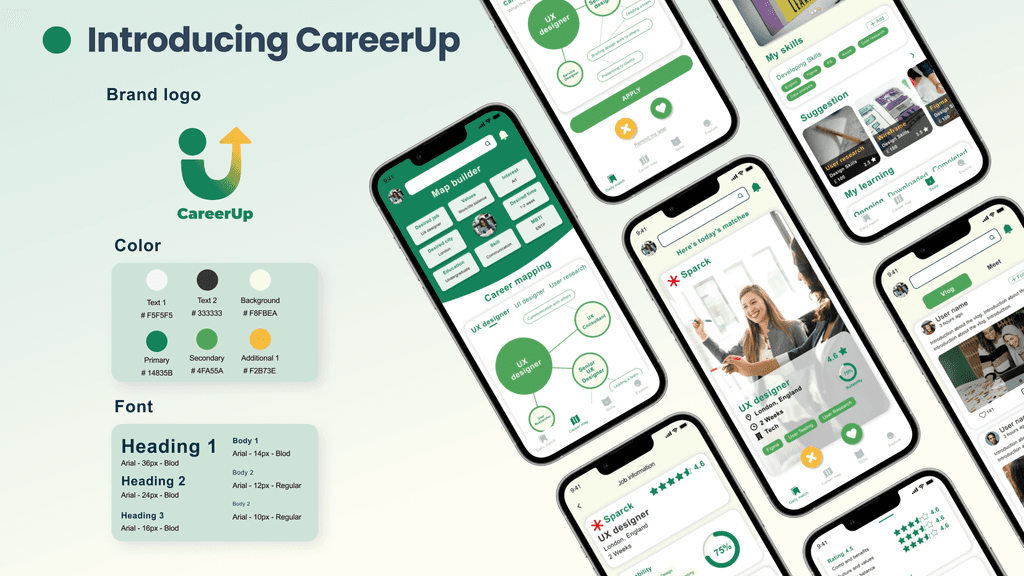
Key Features of the CareerUp! Service:
Career Mapping Tool:
The Career Mapping Tool is the centerpiece of CareerUp!, designed to align students' personal interests, values, and skills with relevant career paths. This AI-powered tool offers a tailored experience, using filters for factors such as work-life balance, salary expectations, location, and job role expectations. Students can visualize career pathways, view role progression, and explore how their skills translate into specific job functions.
Functionality: Users input their preferences and career interests, and the tool generates a customized career map showing potential career trajectories and progression opportunities.
User Benefit: This tool provides clarity on the options available, empowering students to see how their current skills and interests can evolve into fulfilling careers.
Mini Jobs for Real-World Experience:
Recognizing the importance of hands-on experience, the Mini Jobs feature provides students with access to short-term, low-commitment projects and internships. These “mini jobs” help students explore different fields, build experience, and validate their career choices before making long-term commitments.
Functionality: Students can browse available mini-job opportunities, each accompanied by testimonials from professionals or alumni who have worked in similar roles.
User Benefit: This feature addresses students' need for real-world exposure, helping them gain confidence in their choices through practical experience and feedback from professionals.
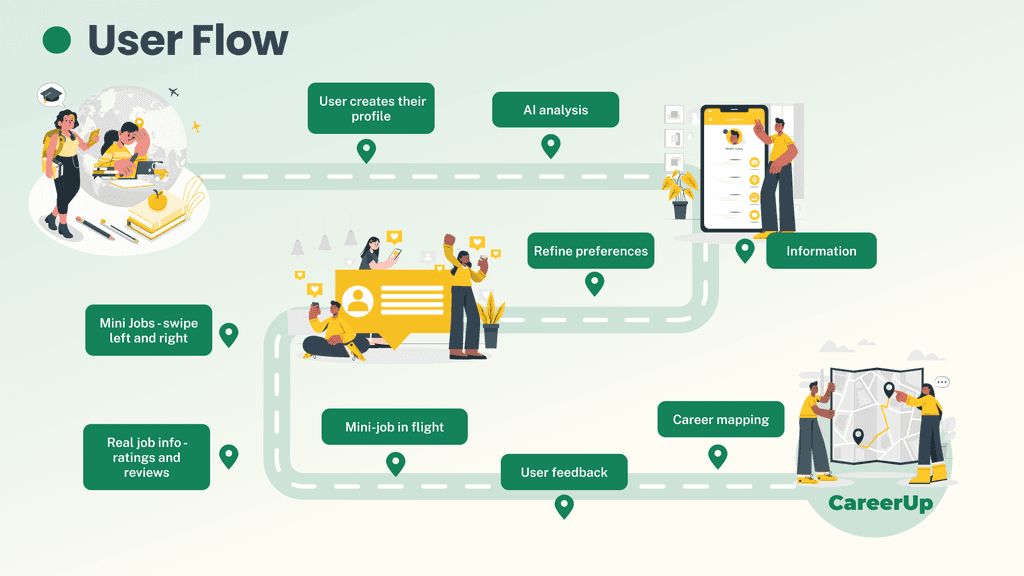
Personalized Job Matching and AI Recommendations:
CareerUp!’s AI-powered recommendation engine tailors job and internship suggestions based on each user’s unique profile, including their academic background, skills, and interests. This feature evolves with the user, refining recommendations as students interact with the platform and provide feedback.
Functionality: Students receive job and internship suggestions that align with their current skills and goals, with options to refine suggestions based on their evolving preferences.
User Benefit: This dynamic, personalized approach ensures students are matched with roles that reflect their interests and strengths, helping them make informed career decisions with greater ease.
Professional Insights and Networking:
CareerUp! integrates real-world testimonials and networking opportunities to support students’ confidence-building. Students can read testimonials from professionals in their fields of interest, learn about real-world expectations, and connect with alumni for mentorship and guidance.
Functionality: Users have access to alumni stories, industry insights, and the option to connect with mentors or participate in Q&A sessions.
User Benefit: This feature helps students build valuable connections and gain authentic perspectives on the roles they are interested in, helping bridge the gap between education and industry.
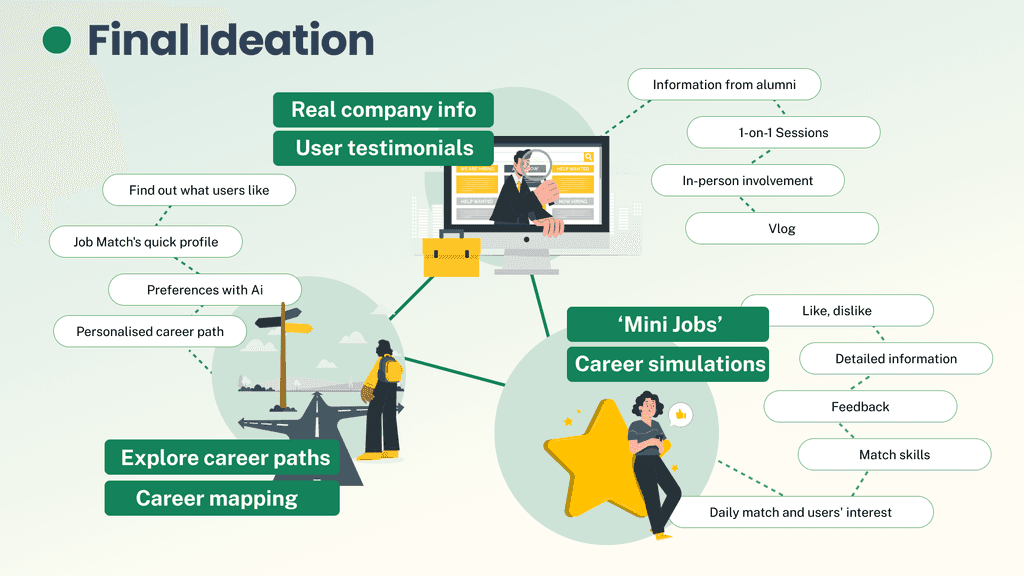
Progress Tracking and Guided User Flow:
CareerUp! includes a built-in progress tracker that helps students navigate their career discovery journey, providing guidance on next steps based on their actions and preferences. This feature ensures a structured, cohesive experience that helps students understand what they need to do to achieve their career goals.
Functionality: A guided user flow with progress indicators shows students where they are in their career exploration journey and suggests actionable next steps.
User Benefit: The progress tracker enhances user engagement, providing a sense of accomplishment and a roadmap to follow as they explore career options.
Design Solution
Outcome & Impact
CareerUp! successfully achieved its goal of providing students with a personalized, accessible, and supportive career guidance tool. The solution was well-received during user testing, with students and career coaches expressing appreciation for its focus on individual needs, practical experience, and ease of navigation. Key features like the Career Mapping tool and Mini Jobs allowed users to explore career paths in a structured, hands-on way, improving their confidence in decision-making.
Key Outcomes:
Enhanced Career Clarity:
Users reported greater clarity about potential career paths and a better understanding of how their interests and skills aligned with real-world roles. The Career Mapping tool proved especially useful in visualizing career trajectories and understanding progression within specific fields.
Increased Confidence Through Practical Experience:
The Mini Jobs feature provided students with much-needed real-world exposure, allowing them to test out careers before making significant commitments. Feedback indicated that this feature was instrumental in helping students build confidence and validate their career interests.
Personalized, User-Centric Guidance:
CareerUp!’s AI-driven recommendations and customizable filters ensured that each user received tailored career suggestions, which were highly valued by students. This personal touch made the platform feel relevant and engaging, increasing overall satisfaction with the career planning process.
Positive Feedback from Stakeholders:
Career coaches and advisors noted the platform’s potential to support educational institutions by filling gaps in traditional career guidance. CareerUp! was seen as a valuable resource that could complement existing career services.

Impact:
Empowering Students for Informed Decisions:
CareerUp! equipped students with the tools they need to make informed, well-considered career choices, ultimately supporting their long-term success and satisfaction in the workforce.
Reducing Anxiety Around Career Choices:
The platform addressed many common anxieties students face when making career decisions. By offering insights, guidance, and experience opportunities, CareerUp! helped students approach their career journey with greater confidence and reduced stress.
Supporting Equity and Inclusivity in Career Guidance:
By offering a highly customizable, accessible platform, CareerUp! provided equitable support to students from diverse backgrounds, regardless of academic achievements. This inclusive approach made the platform particularly valuable for students seeking alternative pathways and work-life balance in their future careers.
Potential for Institutional Integration:
The success of CareerUp! has opened opportunities for scaling the solution and integrating it into academic institutions as a standardized career guidance tool. This scalability could provide universities with a modern, data-driven resource for supporting students in their career journeys.
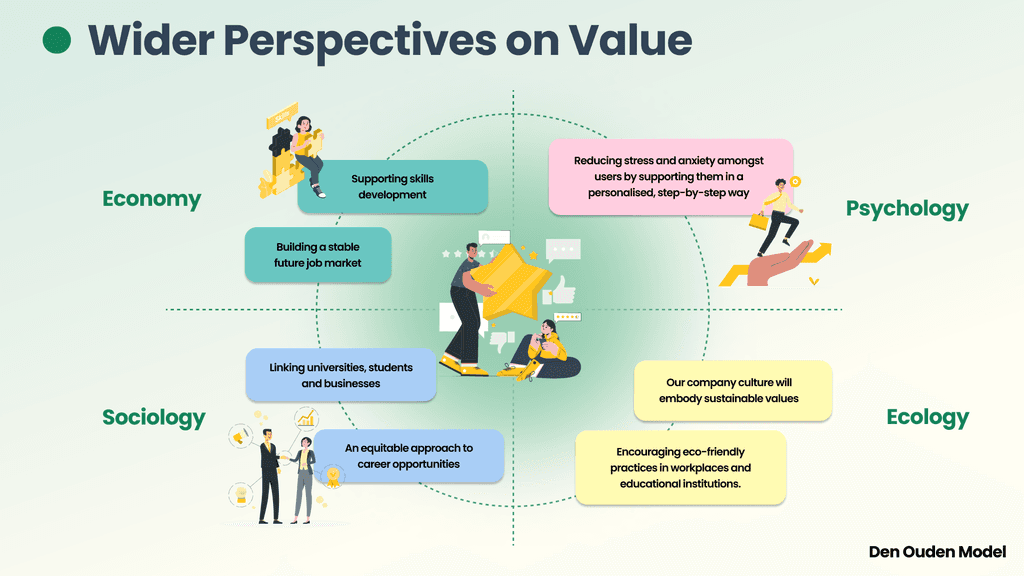
Design Solution
Reflection
The CareerUp! project highlighted the power of user-centered design in addressing complex, highly personal challenges like career decision-making. As the Service Designer, I learned the value of iterating based on real user feedback, which was essential in creating a solution that was both impactful and deeply aligned with user needs. This project strengthened my skills in balancing technical feasibility with a user’s emotional and practical needs, a critical aspect of responsible innovation.
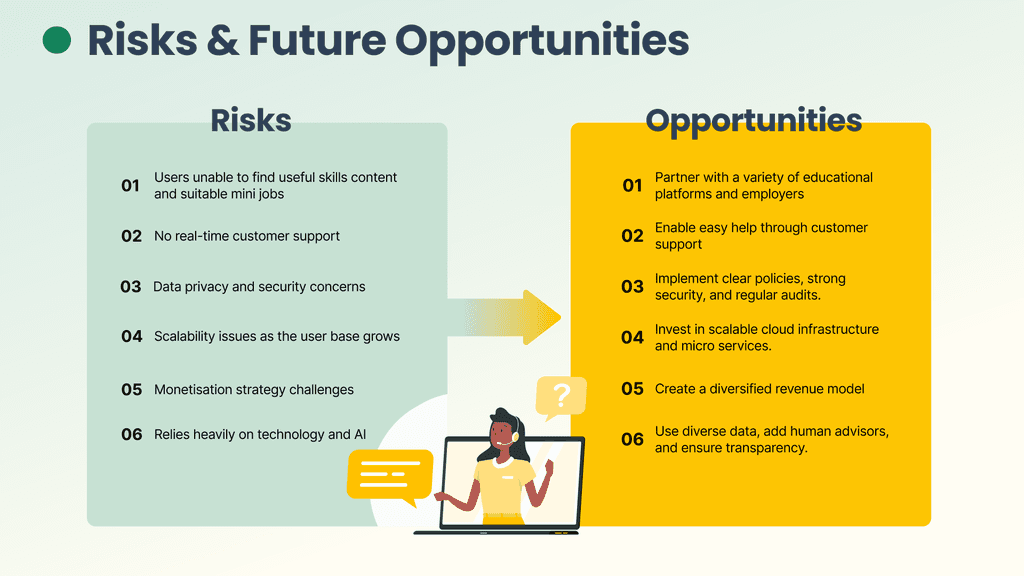
Key Reflections:
Importance of Real-World Validation:
The inclusion of Mini Jobs provided students with a low-risk way to explore careers, underscoring the importance of hands-on experience. This feature demonstrated that real-world exposure can significantly boost user confidence and decision-making clarity.
Balancing Usability with Personalization:
Designing for a diverse user group required balancing a clean, intuitive user experience with deep personalization. By incorporating customization options, we were able to meet diverse needs without overwhelming the user.
Collaboration with Stakeholders:
Regular feedback sessions with Sparck and career advisors were invaluable for aligning CareerUp!’s design with both user needs and business goals. This collaboration highlighted the importance of communication and co-creation in service design.
Responsible Innovation in Practice:
Applying principles of responsible innovation—especially inclusivity and equity—helped ensure that CareerUp! was accessible to students from all backgrounds. This experience reinforced my commitment to designing solutions that promote fairness and accessibility.
